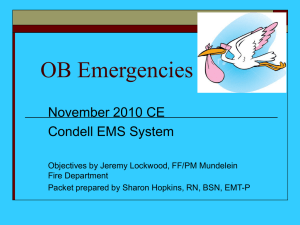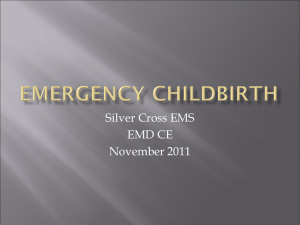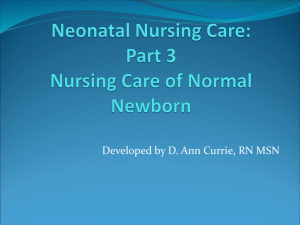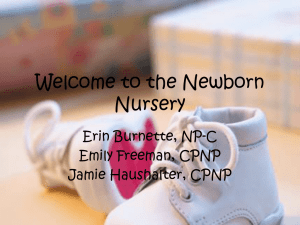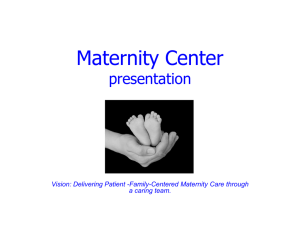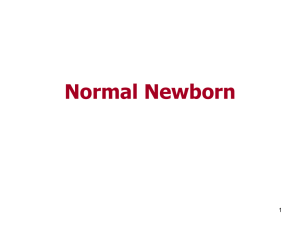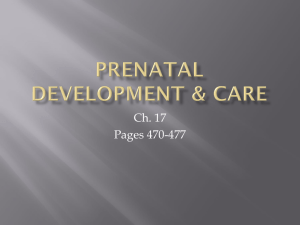November 2014 - CE OB - Advocate Health Care
advertisement
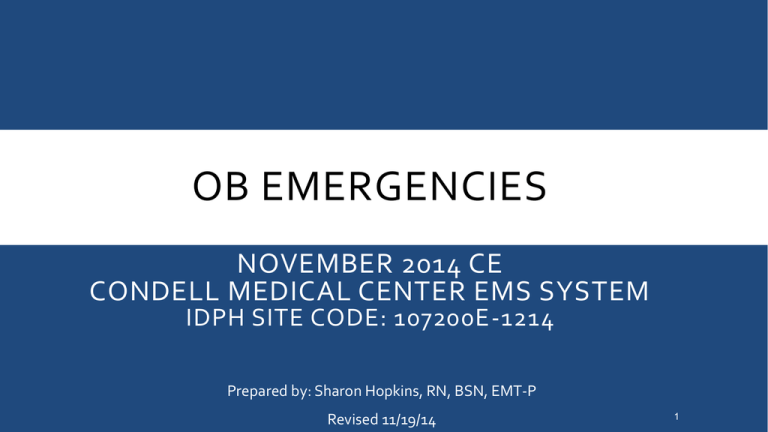
OB EMERGENCIES NOVEMBER 2014 CE CONDELL MEDICAL CENTER EMS SYSTEM IDPH SITE CODE: 107200E-1214 Prepared by: Sharon Hopkins, RN, BSN, EMT-P Revised 11/19/14 1 OBJECTIVES Upon successful completion of this module, the EMS provider will be able to: 1. Define obstetrical terms 2. Describe the physiological changes to the patient who is pregnant. 3. Describe potential complications in the antepartum and post partum periods. 4. Describe EMS interventions for a variety of obstetrical delivery emergencies following the Region X SOP. 5. Identify imminent delivery. 2 OBJECTIVES CONT’D 6. Describe components of an obstetrical kit and the use of the contents. 7. Discuss post-partum depression. 8. Actively participate in review of selected Region X SOP’s. 9. Actively participate in case scenario discussion. 10. Actively participate in return demonstration of BVM use with a neonate. 11. Actively participate in return demonstration of use of the meconium aspirator. 12. Actively participate in return demonstration of use of a BVM in a neonate. 13. Successfully complete the post quiz with a score of 80% or better. 3 TERMINOLOGY OF PREGNANCY Prenatal period – time from conception until delivery of fetus Antepartum – time period prior to delivery Post partum – time interval after delivery Gravidity – number of times pregnant Parity – number of pregnancies to full term Fetus – a developing human in the womb Neonate – the first 30 days of life for the infant Estimated date of confinement (EDC) – estimated birth date 4 TERMINOLOGY CONT’D Placenta – temporary blood-rich structure; lifeline for the fetus Transfers heat Exchanges O2 and carbon dioxide Delivers nutrients Carries away wastes Bag of waters – amniotic sac; surrounds and protects fetus; volume varies from 500 – 1000ml Perineum – the skin between the vaginal opening and the anus Nuchal cord – cord wrapped around the fetal neck 5 PHYSIOLOGICAL CHANGES DURING PREGNANCY Pregnancy is a normal and natural process A woman’s body will undergo many changes in preparation for carrying another life Complications are uncommon but you must be prepared for them Pre-existing medical situations could be aggravated during pregnancy and develop into acute problems 6 PHYSIOLOGICAL CHANGES OF PREGNANCY Nausea and vomiting due to hormonal changes Delayed gastric emptying in renal blood flow Kidneys may not be able to keep up with filtration and reabsorption Bladder displaced anteriorly and superiorly More likely to be ruptured in trauma Urinary frequency Loosened pelvic joints due to hormonal changes 7 PHYSIOLOGICAL CHANGES CONT’D in oxygen demand and consumption Diaphragm pushed up by enlarging uterus lung capacity in cardiac output to 6-7 L/min by end of 2nd trimester Average in resting non-pregnant female is 4.9L/minute in maternal blood volume by 45% Can lose 30-35% total blood loss before change in vital signs are evident venous return to right atrium with gravid uterus compressing inferior vena cava 8 FETAL BLOOD SUPPLY No direct link between mother’s blood and infant Mother’s blood flows to the placenta Placenta supplies blood to the fetus Placenta acts as a barrier protecting the fetus Some items cross the placental barrier and can affect the fetus Alcohol Some medications – Valium Versed, oral diabetic meds, narcotics, some antibiotics, steroids 9 UMBILICAL CORD A flexible, rope-like structure approx. 2 feet long Contains 2 arteries, 1 vein Transports oxygenated blood to fetus Returns relatively deoxygenated blood to placenta Fetus can twist and turn in the uterus and get wrapped up in cord Fetus can “tie umbilical cord into a knot” 10 NORMAL PREGNANCY – 20 WEEKS & TERM 11 ANTEPARTUM COMPLICATIONS Vaginal bleeding Ectopic pregnancy Placenta previa Abruptio Hypertensive disorders Preeclampsia, eclampsia Supine Hypotensive Syndrome 12 VAGINAL BLEEDING May occur at anytime during the pregnancy If early, patient may not even realize they are pregnant In the field, exact etiology cannot be determine Keep heightened suspicion that vaginal bleeding may be related to patient being pregnant This could prove an emotional time for the patient and family Being supportive is important to these patients 13 ECTOPIC PREGNANCY Fertilized egg has implanted outside the normal uterus Patient often presents with abdominal pain Starts diffuse and them localizes to lower quadrant on affected side Patient may not even be aware that they are pregnant If in fallopian tube and tube ruptures, maternal death due to internal hemorrhage is a real possibility Abdomen becomes rigid with pain Often referred shoulder pain on affected side 14 PLACENTA PREVIA Abnormal implantation of placenta on lower half of uterine wall Cervical opening partially or completely covered Placenta can start pulling away from attachment starting at 7th month Painless bright red vaginal bleeding Uterus usually soft Potential for profuse hemorrhage Definitive treatment is cesarean section delivery 15 ABRUPTIO PLACENTA Premature separation of normally implanted placenta from uterine wall Life threat for mother and fetus 20-30% mortality for fetus Signs & symptoms depend on extent of abruption Can have sudden sharp, tearing pain and stiff, board like abdomen Vaginal bleeding could range from none to some Blood could be trapped between placenta and uterine wall Maintain maternal oxygenation and perfusion 16 PRE-HOSPITAL CARE OF ANTEPARTUM BLEEDING Maintain high index of suspicion Treat for blood loss Positioning – lay or tilt left Monitor for adequate oxygenation Providing supplemental oxygen is also for benefit of the fetus Maintain adequate perfusion Consider fluid challenge as needed 200 ml increments with ongoing assessment/ evaluation Expedited transport; transport as soon as possible Early report to receiving facility 17 HYPERTENSIVE DISORDER OF PREGNANCY Major cause of maternal, fetal and neonatal morbidity and mortality Morbidity – presence of a disease state Mortality – relating to death A common medical problem in pregnancy Includes gestational hypertension (hypertension that develops during pregnancy usually after the 20th week) and pre-existing hypertension (typically defined as a blood pressure > 140/90) 18 PREECLAMPSIA Most common hypertensive disorder of pregnancy Increased risk in diabetic, those with history of preeclampsia, and those carrying more than one fetus Progressive disorder; most commonly seen last 10 weeks of gestation, during labor, or first 480 postpartum Have a 30 mmHg increase in systolic B/P and 15 mmHg increase in diastolic B/P over baseline 19 SIGNS AND SYMPTOMS PRE-ECLAMPSIA Elevated blood pressure Headache Visual disturbances – blurred vision, flashing before the eyes Severe epigastric pain Vomiting Shortness of breath Tissue edema related to third spacing with fluid shift into tissues Swelling of face, hands, and feet 20 ECLAMPSIA Most serious side of hypertensive disorders of pregnancy Generalized tonic-clonic seizure activity Often preceded by flashing lights or spots before their eyes Epigastric pain or pain RUQ often precedes seizure Note grossly edematous patient with markedly elevated B/P High mortality rates for mother and fetus Definitive treatment is delivery EMS needs to provide support until delivery at closest appropriate facility 21 MANAGING SEIZURES DURING PREGNANCY Positioning of patient To protect from harm, protect airway Maintain patent airway Potential need for intermittent suction Support ventilations Patient’s respirations altered during active seizure activity Will need supportive ventilations especially in presence of long lasting seizure activity Manage seizure with Versed 2 mg IN/IVP/IO every 2 minutes up to 10 mg (does cross the placental barrier; could depress fetus) 22 SUPINE HYPOTENSIVE SYNDROME Usually occurs in 3rd trimester Gravid uterus compresses inferior vena cava when mother lies supine Mother may experience dizziness Evaluate for volume depletion versus positioning problem Place mother in left lateral recumbent position (“lay left”) for assessment, treatment, and transportation to prevent this problem 23 IDENTIFYING IMMINENT DELIVERY Mother entering the 2nd stage of labor Measured from complete dilation of cervix (10cm) to delivery of fetus Could last 50-60 minutes for first pregnancy Contractions strong lasting 60-75 seconds and 2 -3 minutes apart Membranes may rupture Has urge to push Perineum bulging Crowning evident when head or other presenting part is evident at vaginal opening during a contraction 24 OB KIT CONTENTS AND ADD-ONS Cap ID bands 25 STEPS TO TAKE DURING DELIVERY Try for a private area if out in public Place patient on her back with room to flex knees and hips Prepare equipment – OB kit Coach mother to breath between contractions and to push with contractions once crowning is evident Support head as it emerges Check for nuchal cord Clear the airway with a bulb syringe if secretions present 26 DELIVERING THE BABY 27 DELIVERY CONT’D Gently guide baby’s head downward Facilitates delivery of upper shoulder Then gently guide baby’s body upward Facilitates delivery of lower shoulder Rest of baby quickly delivers Be prepared! Infant will be slippery! Note time of delivery – when baby totally out Keep baby in head down position 28 DELIVERING THE BABY 29 USE OF BULB SYRINGE Routine suctioning is no longer recommended Suctioning has been associated with bradycardia and other problems Suctioning is limited to necessity If performed, suction MOUTH, then nose Suctioning the nose is the stimulus to breath Want the airway clear prior to stimulation to take a breath Infant will not start to breath until their chest clears the birth canal and can then expand 30 DELIVERING THE BABY 31 NORMAL APPEARANCE OF NEWLY BORN Infants will be wet and slippery Covered with a cheesy like substance that wears off shortly after delivery Hands and feet may be cyanotic longer that other parts of the body Extremities should be actively moving 32 NEWLY BORN APPEARANCE Risk for blood and body fluid contamination during all deliveries Have high regard for use of appropriate PPE’s! Drying off preserves heat and acts as a stimulus by the rubbing activity 33 INITIAL ASSESSMENT OF NEWBORN Begin steps of inverted pyramid as you are assessing newborn Begin to dry infant; change to dry towel as needed Cold infants can deteriorate quickly Infants have difficult time generating & maintaining body heat; they cannot shiver to generate heat Suction with bulb syringe only when secretions are present Suctioning when not necessary associated with bradycardia and other problems Assess newborn as soon as possible after birth Normal respiratory rate averages 30-60 breaths per minute Normal heart rate ranges from 100 – 180 beats per minute 34 INVERTED PYRAMID (Always needed) (Infrequently needed) 35 APGAR SCORE Developed in 1953 by Dr. Apgar, a surgeon turned anesthesiologist An assessment is taken at 1 and 5 minutes after birth The 1 minute score reflects how well the infant tolerated the birthing process and indicates need for early intervention The 5 minute score reflects how well the infant is tolerating being outside the womb as well as response to interventions provided The higher the score (closer to 10), the better the infant’s transition Early duskiness of distal extremities is common often leading to a 1 minute score of 9 The score does NOT predict the future health of the child 36 APGAR CONT’D Any score less than 7 merits an intervention Supplemental airway Clearing the airway Physical stimulation Rubbing the back Flicking the bottom of the foot Most low initial scores at 1 minute improve with the usual interventions listed at the top of the pyramid and by the 5 minute assessment, are usually at higher, acceptable scores Providing assessment/reassessment will be key 37 38 CARE OF THE CORD Do not pull on the cord Avoid cutting the cord prematurely Want the last kick of blood available to be delivered to the infant Once the cord has stopped pulsating and gone limp, can prepare to clamp and tie it Place one clamp 8 inches from newborn’s navel Place 2nd clamp about 2 inches further away Cut exposed cord between the clamps – it’s tougher than anticipated Continue to assess the newborn’s end of exposed cord for any bleeding39 CARE OF THE CORD There is no rush to clamp and cut the cord You want to give enough time for all blood possible to infuse from mother to the placenta to the infant Infant's have a very limited blood volume to begin with (80 ml/kg) 40 PREVENTING HEAT LOSS Heat loss can be life threatening for the newborn Most heat loss is via evaporation while wet with amniotic fluid Can lose heat via convection depending on temperature of room and movement of air around newborn Can lose heat via conduction if in contact with cooler objects Can radiate heat to colder nearby objects 41 PRESERVING THE NEWBORN’S BODY TEMPERATURE Dry the newborn immediately after birth Maintain a warm ambient temperature Close all windows and doors Replace wet towels with dry Keep infant wrapped and head covered to prevent heat loss Mother holding the newborn transfers her body heat 42 NEWBORN RESUSCITATION Additional efforts required when the respiratory rate is decreased, heart rate <100, or there is decreased muscle tone Attempt positive pressure ventilations via BVM Rate of 40- 60 breaths per minute Watch that the volume is enough to make the chest rise and fall Reassess after 30 seconds IF heart rate is 60 -100 beats per minute Continue positive pressure ventilation IF heart rate is less than 60 Begin chest compressions at a ratio of 3:1; reevaluate every 30 seconds 43 3RD STAGE OF LABOR – PLACENTAL STAGE Uterus continues to contract Cord appears to lengthen May have increase in bloody discharge If delivered, transport with mother to the hospital 44 COMPLICATIONS – PROLAPSED CORD Umbilical cord visible prior to delivery Cord will be compressed if fetus passes through birth canal Goal Prevent mother from delivering vaginally 45 PROLAPSED CORD This is one of the complications you want to visually check for as quickly as possible once on the scene of an imminent delivery If the cord is visible protruding from the vagina Elevate the mother’s hips Instruct patient to pant during contractions or just keep her breathing during a contraction Place gloved hand into vagina between pubic bone and presenting part Monitor cord between fingers for pulsations Keep exposed cord moist with dressings and keep warm Transport with hand in place – DO NOT REMOVE YOUR FINGERS 46 MECONIUM STAINING Occurs in approximately 10-15% of deliveries Meconium is dark green and can be of thin or thick consistency Fetal distress and hypoxia cause meconium to pass from the fetal GI tract into the amniotic fluid If infant is breech, meconium staining is anticipated and expected as the abdomen is compressed in the birth canal Meconium aspiration increases neonatal mortality rate If aspirated can obstruct small airways & cause aspiration pneumonia and lead to respiratory distress 47 NORMAL MECONIUM STOOL Usually passed within 480 of birth Typically transitions to normal stool beginning by day 4 Meconium is thick, dark almost black stool normally found in the infant’s intestines Becomes a problem when aspirated or otherwise blocks the infant’s small airways 48 MECONIUM – THIN OR THICK? If thin, may not require any intervention if infant is vigorous No problems with respiratory rate Normal muscle tone Heart rate over 100 beats per minute Bulb syringe easily takes care of most cases of meconium Infant is not vigorous – will need interventions Decreased respirations Decreased muscle tone Heart rate < 100 beats per minute 49 IF INTERVENTION REQUIRED FOR MECONIUM If interventions required, must move quickly You have limited time to intervene You must be proactive and anticipate use of equipment Suctioning with meconium aspirator needs to be performed prior to the infant’s need to take their first breath If you are organized and efficient, you MAY get the opportunity to suction twice You probably won’t get the opportunity for more than two attempts 50 EQUIPMENT FOR MECONIUM ASPIRATION Suction tool Suction force turned down to 80 mmHg Meconium aspirator Intubation blade and handle 2 ETT of anticipated size Additional ETT sized below and above anticipated size to use Stylet Neonatal BVM 51 PRESENCE OF MECONIUM Suctioning must occur prior to infant being stimulated It is more efficient if performed as a team effort in the non-vigorous infant Provide blow-by oxygen during procedure to keep environment oxygen enriched Blade can be left in position as first ETT is removed Assistant should be ready to attach meconium aspirator to proximal end of ETT as soon as stylet is removed New, clean ETT with stylet needs to be prepared & ready to be used as soon as 1st ETT is removed 52 MECONIUM ASPIRATOR Connect small end of meconium aspirator to suction connecting tube Set suction down to 80 mmHg Endotracheal tube inserted using blade and handle Meconium may obscure your view Wider end of aspirator connected to proximal end of ETT Thumb placed over suction port while withdrawing ET tube within 2 seconds Discard ETT after 1 sweep and use new ETT if 2nd attempt made 53 SUPPORTIVE VENTILATION Proper positioning is a small towel under the torso Volume is enough to make the chest rise gently Rate is 40-60 breaths per minute Do not flow oxygen into the infant’s eyes or put pressure over the eyes Newborns are sensitive to vagal stimulation and will respond with bradycardia 54 NUCHAL CORD Cord is wrapped around the infant’s neck Problem exists if the cord is too tight and prevents infant from delivering Remember: fetus is receiving their oxygen and blood supply via the cord If cord clamped and cut prematurely, infant needs to be delivered without delay to begin to ventilate on own Goal: If cord too tight for infant to deliver, then unwrap or clamp & cut Prevent mother from pushing until cord is unwrapped or cut 55 POSTPARTUM HEMORRHAGE Loss of more than 500 ml of blood immediately following delivery 500 ml = 2 cups = 16 oz = 1 pint = 1 pound by weight of soaked pad Most common cause is uterine atony – lack of uterine tone; failure of uterus to contract after delivery Occurs more frequently in multigravida and more common following multiple births or births of large infants Rely on clinical appearance of mother and vital signs Uterus often feels boggy on palpation Need to perform fundal massage 56 FUNDAL MASSAGE – 2 HANDED TECHNIQUE Must NOT be performed until after delivery of the placenta Is a 2 handed technique Performed to get uterus to contract to minimize blood loss Need the uterus to firm up Should feel like a grapefruit or fist 57 FETAL ALCOHOL SYNDROME (FAS) Life long effects started from the womb When the mother drinks, alcohol crosses the placenta and passes to the fetus Alcohol affects neurons and the central nervous system (CNS) of the fetus Damages physical structures and growth Defects more pronounced as the child grows 58 CRISIS AT BIRTH If FAS is suspected: Anticipate a small weight newborn Anticipate a newborn who may need some resuscitative efforts Assisted ventilations Extra attention to be kept warm due to typically a smaller birth weight 59 FETAL ALCOHOL SYNDROME (FAS) Signs and symptoms noted at birth related to effects of hypoglycemia and dehydration Newborn has a “hangover” following binge drinking of the mother Typical appearance Underweight; “skinny” Irritable Poor reserves Changes in facial features 60 FETAL ALCOHOL SYNDROME 61 FETAL ALCOHOL SYNDROME (FAS) All defects last a lifetime Neurological defects include Motor skills; poor pace of walking Memory impairment; learning disabilities Poor social skills Potential for heart murmur, joint defects, hearing problems, renal problems 62 SIDS Sudden infant death syndrome describes the unexplained sudden death of an infant Major cause of death in infant’s first month of life Most victims appear healthy prior to death There is still no cause of SIDS but theories do exist Stress in infant possibly from infection or other factors A birth defect Failure to develop A critical period of rapid growth 63 SIDS SIDS cannot be prevented or predicted Death seems to occur during sleep There are no warning signs or symptoms Parents will need emotional support Parents will often blame themselves “I should have…” “I should not have…” Each case is handled individually in regards to EMS response 64 POST PARTUM DEPRESSION Many symptoms may be experienced by the new mother EMS responding to “an accident” may be caring for a mother experiencing postpartum depression Our biggest fear is that the patient may be experiencing issues that may take over and lead them to do harmful things to themselves and/or the children Just be alert to potential situations that may be more than they appear to be Like the MVC that may be a suicide attempt 65 POST PARTUM DEPRESSION SYMPTOMS Being overwhelmed, irritated, angry, no patience Feel this is more than just “hard”; feels like she can’t handle being a mother Sadness to the depth of their soul Inability to stop crying Can’t concentrate; feel disconnected Having thought of running away, or of hurting self or the baby Confused and scared 66 CASE SCENARIO DISCUSSION Review the following cases and determine what your general impression is Discuss what your intervention needs to be Refer to the Region X SOP’s as necessary 67 CASE SCENARIO #1 EMS is called to the scene of a mother who is in labor What questions are important to ask early? Number of pregnancies Due date Known complications Previous labor history if any If bag of waters are intact or broken The duration and frequency of contractions In report, provide weeks of gestation and not the months Provides more precise picture of age of infant (i.e.: premature or not) 68 CASE SCENARIO #1 What indicates that delivery is imminent? Crowning Bulging of the perineum Contractions that are lasting 60-75 seconds and coming every 2-3 minutes Urge to push Feeling that she wants to have a bowel movement 69 CASE SCENARIO #1 What is assessed with the APGAR score? A – appearance or coloring Fingers and toes often bluish for a few minutes P – pulse Best to have a pulse over 100 beats per minute G – grimace or reflexes Grimacing, coughing, sneezing are good to see A – activity or muscle tone Want to see flexed extremities R – respiratory effort Want to hear a strong cry 70 CASE SCENARIO #1 What are the interventions listed at the top of the inverted pyramid that each newborn typically receives? Drying – to prevent heat loss by evaporation Warming the infant to stop the heat loss Stimulation by touching and rubbing the infant Flicking the bottom of the feet or rubbing the back if more tactile stimulation is required Keeping the newborn in a head down position to facilitate drainage from the lungs 71 CASE SCENARIO #2 You have arrived on the scene and determined that you will need to deliver a newborn During assessment and in preparation of the event, you notice dark, thick greenish-black flecks of material in the leaking bag of waters What does this indicate? Evidence of meconium staining What does this mean? If not a breech delivery, the fetus may be in distress and require extra resuscitative efforts 72 CASE SCENARIO #2 What equipment do you need to prepare? Neonatal BVM Meconium aspirator Several endotracheal tubes Several stylets Blade and handle Oxygen source Suction device – turned down to 80 mmHg 73 CASE SCENARIO #2 What assessment of the newborn would indicate a need to use a meconium aspirator? If the infant is not vigorous The respiratory rate is decreased There is decreased muscle tone – newborn is limp Heart rate is below 100 beats per minute Remember: a bulb syringe works just fine for most situations involving the presence of meconium at birth Depress the bulb prior to inserting into the mouth and nose 74 CASE SCENARIO #3 You are on the scene and have just assisted the mother in delivering her 3rd child The infant is not as responsive to drying and stimulation as you feel they should be and extremities are dusky You want to provide blow-by oxygen How would you deliver blow-by oxygen? Hold a source of oxygen next to the infant's nose and mouth and let the oxygen source “blow-by” 75 CASE SCENARIO #3 The infant is not responding to the blow-by efforts The respiratory rate is low and the heart rate is less than 100 What is your next intervention? Begin positive pressure ventilations at 40-60 breaths per minute Ventilate with small puffs of air Reevaluate every 30 seconds 76 CASE SCENARIO #3 What would you do if the pulse remained between 60 and 100? Continue positive pressure ventilations Reassess every 30 seconds What would you do if the pulse dropped below 60 in the newborn? Begin chest compressions 3 compressions to 1 ventilation Depress the sternum 1/3 the AP diameter of the chest on lower half of sternum 77 CASE SCENARIO #4 You are on the scene for a patient who fell Upon your arrival you note an unresponsive adult on the floor who is obviously pregnant Your patient is in a tonic-clonic seizure What is your general impression? First thought is eclampsia Need to consider an epileptic seizure Need to be thinking possible hypoglycemia Need to determine presence of head injury 78 CASE SCENARIO #4 What are your actions during this on-going seizure activity? Protect the patient from harm Maintain a patent airway Suction available Turn patient on left side Also avoids supine hypotensive syndrome Consider supporting ventilations via BVM 1 breath every 5-6 seconds (10-12 breathe per minute) Obtain any medical history available 79 CASE SCENARIO #4 What medication is used in the presence of seizure activity in the patient who is pregnant? Versed 2mg IN/IVP/IO May repeat every 2 minutes titrated to desired effect Maximum dose of 10 mg If seizure activity continues or reoccurs, contact Medical Control for additional orders of Versed up to an additional 10 mg 80 CASE SCENARIO #4 What would be important to relay in your face to face hand-off report with this case once at the hospital? Fact that Versed was administered Versed crosses the placental barrier If administered close to the time of delivery, may witness side effects in the newborn related to the Versed Respiratory depression Hypotension Would be important for OB to try to differentiate if signs or symptoms are due to the condition of the newborn or related to interventions performed 81 BIBLIOGRAPHY Bledsoe, B., Porter, R., Cherry, R. Paramedic Care Principles & Practices, 4th edition. Brady. 2013. Mistovich, J., Karren, K. Prehospital Emergency Care 9th Edition. Brady. 2010. Region X SOP’s; IDPH Approved January 6, 2012. http://www.primehealthchannel.com/fetal-alcohol-syndrome-pictures-symptoms-statisticsand-treatment.html http://www.emedicinehealth.com/postpartum_depression/article_em.htm http://www.nlm.nih.gov/medlineplus/ency/article/003402.htm http://www.pphprevention.org/pph.php http://calsprogram.org/manual/volume1/Section4_Path/05-PATH4NeonatalEmergencies13.html http://www.cdc.gov/vhf/ebola/hcp/procedures-for-ppe.html 82
